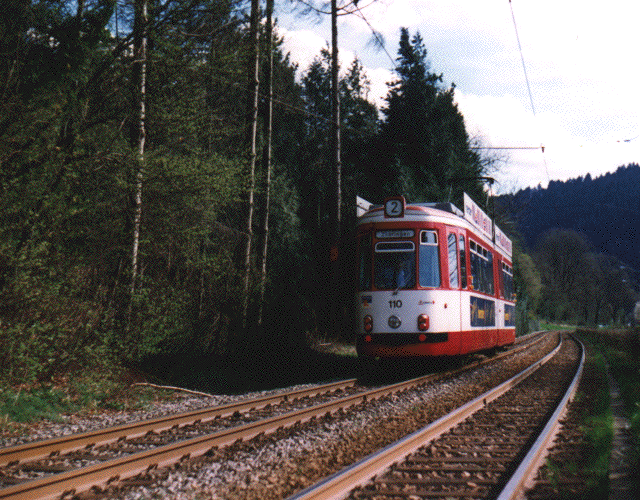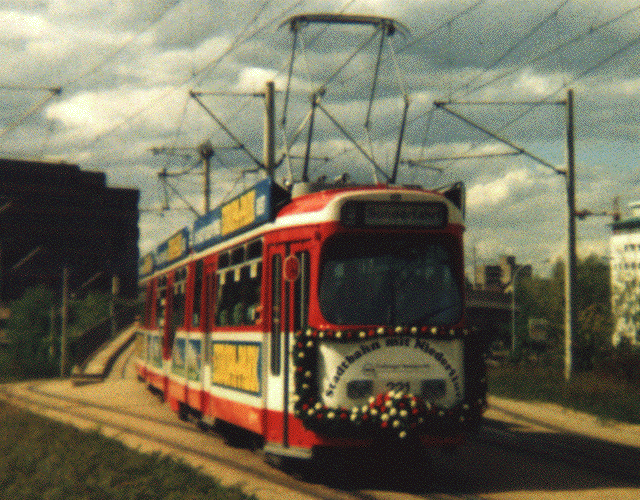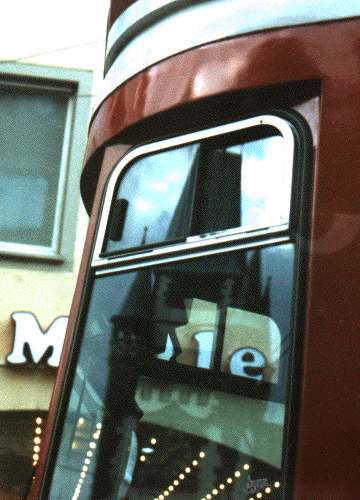a view
Trams running through the narrow cobbled streets of an old town, and even squeezing through the arches of the ancient city gates are rare nowadays. Especially if the system in question is not an archaic operation struggling to justify it's usefulness, or even a tourist attraction, but a modern, popular and growing transport system.
|
L I N E S |
|
|
|
|
|
|
|
|
|
|
|
|
|
L I N K S |
When I first came to Freiburg in 1988, there were 5 tram routes. The East-West axis (route 1) was the most modern with it's red and white double articulated GT8 cars. Wheras the Eastern (Littenweiler) leg was part of the old tram system, (albeit realigned on reserved tracks along considerable sections), the Western (Landwasser) leg was less than 10 years old, and included a number of impressive bridges and flyovers. It's opening had been a key event in the success of the tramway system, and it's success was highly applauded. The journey times offered would be difficult to achieve by road, even in abscence of congestion. Of course, in the centre, the trams ran along the narrow (thankfully pedestrianised) streets of the old town, past shops and cafes and under the arches of the Schwabentor (one of the two surviving mediaevil city gates, both of which are used by trams).

The success of this route was such that despite the high capacity cars running at short headways, additional cars were having to be drafted in to cope with the demand.
The other routes were still worked by the small GT4 units, many of which still carried their beige livery much as they had done when they were new in the 1960's. Most of these routes were street running. Route 2, however, extended South in an idyllic inter-urban fashion crossing gardens and meadows for almost 2km on roadside sleepered track before reaching the village of Günterstal. Here it adapted itself to it's new setting, and ran on single-track down the village street (including another narrow arch) to it's modest terminus.

Scarcer, but definitely worth waiting for were various older or more exotic units. There were a number of ex-Stuttgart GT4s running in pairs on route 1 (still in their Stuttgart yellow and white). These proved unpopular with the public and staff (having been used to the comforts of the GT8), and most were used at peak times only. I found this a pity as they were attractive units.
Then there were also the venerable yet crude 'Sputnik' cars of route 3. They were the first articulated cars delivered to Freiburg and dated from 1959. The design was basically a box-shaped traditional four-wheeler with a rear section supported on a bogie.
That was 1988.
Since then, the scene has changed dramatically. New lines have been opened following the model set by route 1. New cars have been delivered and old types have vanished. The new cars are all low-floor, facilitating access.
 All public transport operations in the Freiburg area have been integrated into a single fares structure which has led to a further rapid rise in ridership. Further plans for expansion exist which will doubtlessly bring exciting new prospects to the city.
All public transport operations in the Freiburg area have been integrated into a single fares structure which has led to a further rapid rise in ridership. Further plans for expansion exist which will doubtlessly bring exciting new prospects to the city.
Yet essentially, the character of the system has remained, and operations are, if anything, more varied than in 1988.
I left Freiburg for Zürich in 1991. I am no longer as 'in touch' as I once was, but still come to Freiburg regularly and always enjoy the trams.
last updated 18.10.06.
counter added 17.11.99.
mailto: shadowfax@datacomm.ch
